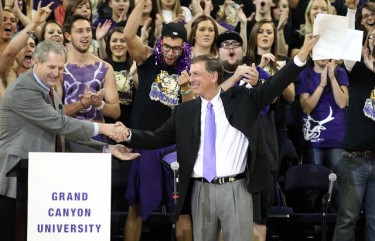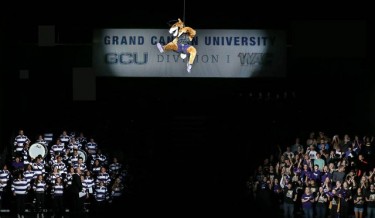By Bob Romantic
GCU News Bureau
Grand Canyon University is the newest member of the Western Athletic Conference.
It may not hold that distinction for long.
Interim WAC Commissioner Jeff Hurd said Tuesday he hopes to have at least one more announcement before the end of the year about another school joining the conference as it transitions from a Football Bowl Subdivision conference to a non-football NCAA Division I conference.
“In a perfect world, I’d like to have eight schools for next year, with a goal of being 10 eventually,” Hurd said following Tuesday’s news conference at GCU Arena that announced the Antelopes’ move to Division I athletics in the WAC. “If we can get to eight and can maintain that for a couple years, at the same time we can try to identify the good fits for teams 9 and 10.”
Currently, there are six teams in the WAC for the 2013-14 school year: New Mexico State, Seattle, Idaho, Cal State Bakersfield, Utah Valley and GCU. (Denver announced Tuesday it is leaving the WAC to join the Summit League next season.)
To maintain its automatic berth in the NCAA men’s and women’s basketball tournaments, the WAC must have seven postseason-eligible members. Grand Canyon does not count toward that total until it completes a four-year transition period to Division I. So, for now, the WAC has only five members who fulfill that requirement.
“I think we’ll be OK,” Hurd said of the prospects of adding two more schools by the end of the year. “I can’t promise that because I don’t know for certain, but our intent is to not have to use the waiver period next year.”
| More on the WAC |
| WAC snapshots: A quick look at the existing members of the WAC |
| What they said: Jerry Colangelo, Jan Brewer, John McCain and others weigh in during Tuesday’s press conference |
A conference that does not have the requisite seven members is granted a two-year waiver period to retain the automatic NCAA bids while it tries to reach that level.
Keith Baker, director of athletics at GCU, said the University’s inclusion in the WAC has some similarities to when it joined the Pacific West Conference in Division II. At the time, the conference included only four Hawaii schools, Dixie State and Grand Canyon. Today, the PacWest consists of 14 teams and is one of the stronger conferences in Division II.
“That may be one of the things we can bring to the WAC,” Baker said. “We’d like to be part of a similar restructuring. We can help identify like institutions and identify competition to our student-athletes that will put them in the national spotlight.”
The WAC has a rich history and has been around for 50 years – Arizona State and the University of Arizona were charter members – with football in the mix for all of that time period. But during the great NCAA realignment shuffle of the last few years, football-playing schools in the WAC have been leaving for other conferences. Five current members are playing their final seasons in the WAC. Louisiana Tech and Texas-San Antonio are joining Conference USA, San Jose State and Utah State will become members of the Mountain West, and Texas State will go to the Sun Belt in 2013. Of the two remaining WAC schools that play football, Idaho has announced it will rejoin the Big Sky Conference in 2014-15, and New Mexico State will play next season as an independent in football.
Hurd is trying to fill those voids with non-football-playing universities so that it can become a non-football conference similar to the Big West, West Coast, Summit, Horizon, Atlantic 10, Atlantic Sun, America East and Metro Atlantic conferences.
“In essence, the WAC is reinventing itself,” Hurd said. “Much like Grand Canyon is transitioning from Division II to Division I, we are transitioning from an FBS-level Division I football conference to a non-football-oriented conference.”
Among the schools being mentioned as possible WAC additions are Texas-Pan-American and Chicago State, both members of the Great West Conference (which, due to defections, is down to three members for next season – New Jersey Institute of Technology being the other).
“If we add whoever it is, A, B or C, we have to look at that institution’s growth potential, what are their resources, what is their commitment on the part of the university,” Hurd said. “Today, it may not be where we want it to be, but can it get there?”
That, Hurd added, is what made GCU an attractive addition to the conference.
“It has the resources, it has the location and it has the vision institutionally to grow as a university and as an athletic department. That’s important,” he said. “All the dynamics are in place.”
Contact Bob Romantic at 639.7611 or [email protected].

















